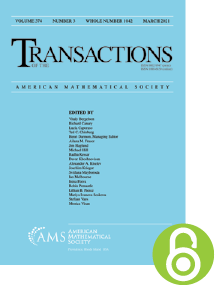A measure theoretical subsequence characterization of statistical convergence
HTML articles powered by AMS MathViewer
- by Harry I. Miller PDF
- Trans. Amer. Math. Soc. 347 (1995), 1811-1819 Request permission
Abstract:
The concept of statistical convergence of a sequence was first introduced by H. Fast. Statistical convergence was generalized by R. C. Buck, and studied by other authors, using a regular nonnegative summability matrix $A$ in place of ${C_1}$. The main result in this paper is a theorem that gives meaning to the statement: $S = \{ {s_n}\}$ converges to $L$ statistically $(T)$ if and only if "most" of the subsequences of $S$ converge, in the ordinary sense, to $L$. Here $T$ is a regular, nonnegative and triangular matrix. Corresponding results for lacunary statistical convergence, recently defined and studied by J. A. Fridy and C. Orhan, are also presented.References
- Patrick Billingsley, Ergodic theory and information, John Wiley & Sons, Inc., New York-London-Sydney, 1965. MR 0192027
- Patrick Billingsley, Probability and measure, Wiley Series in Probability and Mathematical Statistics, John Wiley & Sons, New York-Chichester-Brisbane, 1979. MR 534323
- R. Creighton Buck, Generalized asymptotic density, Amer. J. Math. 75 (1953), 335–346. MR 54000, DOI 10.2307/2372456
- Yuan Shih Chow and Henry Teicher, Probability theory, Springer-Verlag, New York-Heidelberg, 1978. Independence, interchangeability, martingales. MR 513230, DOI 10.1007/978-1-4684-0062-5
- J. S. Connor, The statistical and strong $p$-Cesàro convergence of sequences, Analysis 8 (1988), no. 1-2, 47–63. MR 954458, DOI 10.1524/anly.1988.8.12.47
- Jeff Connor, On strong matrix summability with respect to a modulus and statistical convergence, Canad. Math. Bull. 32 (1989), no. 2, 194–198. MR 1006746, DOI 10.4153/CMB-1989-029-3
- Jeff Connor, Two valued measures and summability, Analysis 10 (1990), no. 4, 373–385. MR 1085803, DOI 10.1524/anly.1990.10.4.373
- Richard G. Cooke, Infinite matrices and sequence spaces, Dover Publications, Inc., New York, 1965. MR 0193472
- H. Fast, Sur la convergence statistique, Colloq. Math. 2 (1951), 241–244 (1952) (French). MR 48548, DOI 10.4064/cm-2-3-4-241-244
- J. J. Sember and A. R. Freedman, On summing sequences of $0$’s and $1$’s, Rocky Mountain J. Math. 11 (1981), no. 3, 419–425. MR 722575, DOI 10.1216/RMJ-1981-11-3-419
- A. R. Freedman and J. J. Sember, Densities and summability, Pacific J. Math. 95 (1981), no. 2, 293–305. MR 632187, DOI 10.2140/pjm.1981.95.293
- J. A. Fridy, On statistical convergence, Analysis 5 (1985), no. 4, 301–313. MR 816582, DOI 10.1524/anly.1985.5.4.301
- J. A. Fridy and H. I. Miller, A matrix characterization of statistical convergence, Analysis 11 (1991), no. 1, 59–66. MR 1113068, DOI 10.1524/anly.1991.11.1.59
- J. A. Fridy and C. Orhan, Lacunary statistical convergence, Pacific J. Math. 160 (1993), no. 1, 43–51. MR 1227502, DOI 10.2140/pjm.1993.160.43 —, Lacunary statistical summability (to appear).
- I. J. Schoenberg, The integrability of certain functions and related summability methods, Amer. Math. Monthly 66 (1959), 361–375. MR 104946, DOI 10.2307/2308747
Additional Information
- © Copyright 1995 American Mathematical Society
- Journal: Trans. Amer. Math. Soc. 347 (1995), 1811-1819
- MSC: Primary 40C05; Secondary 40A99, 40D25
- DOI: https://doi.org/10.1090/S0002-9947-1995-1260176-6
- MathSciNet review: 1260176


